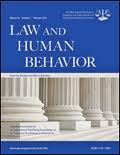The Deviant Responding (DV) and Virtuous Responding (VR) validity scales of the Psychopathy Personality Inventory – Revised (PPI-R) distinguish between those who respond honestly and those who over-report or under-report symptoms. This is the bottom line of a recently published article in Law and Human Behavior. Below is a summary of the research and findings as well as a translation of this research into practice.
Featured Article| Law and Human Behavior | 2013, Vol. 37, No. 5, 312-320
Examining the Necessity for and Utility of the Psychopathic Personality Inventory – Revised (PPI-R) Validity Scales
Author
Abstract
The present study aimed to investigate the need for and utility of the Psychopathic Personality Inventory—Revised (PPI–R) Deviant Responding (DR) and Virtuous Responding (VR) validity scales in identifying overreporting and underreporting, respectively. Since the PPI–R was published, there has not been an independent peer-reviewed examination of these scales. Participants were 384 undergraduate individuals asked to respond to the PPI–R under standard, underreporting, or overreporting instructions. A comparison group consisting of 200 forensic psychiatric patients was also used for the overreporting analyses. Effects of response bias on mean elevations on the PPI–R substantive scales were examined along with the effects on the PPI–R total, factor, and content scales’ correlations with other relevant extratest measures of psychopathy. Mean elevations differed significantly, and correlations with extratest measures of psychopathy were significantly lower. Substantial decrement in psychometric validity of PPI–R scores was observed in the simulation conditions. In addition, the utility of the PPI–R validity scales in differentiating between groups was also determined. Both the VR and DR scales showed utility in differentiating between their respective dissimulation condition and the comparison groups, with acceptable rates of sensitivity and specificity.
Keywords
psychopathy, Psychopathic Personality Inventory- Revised, PPI-R, validity scales, malingering
Summary of the Research
This research was conducted with two objectives in mind. First, to examine the need for validity scales on the Psychopathic Personality Inventory – Revised (PPI-R; a self-report measure of psychopathy) by determining the effects of over- and under-reporting on the total score, factor scores, mean elevations on the substantive scales, and the correlations between PPI-R content scales and other self-report measures of psychopathy. Second, to determine the psychometric validity of the Deviant Responding (DR) and Virtuous Responding (VR) scales and the utility of these scales for differentiating between honest responders, over-, and under-reporters.
A battery of self-report measures of psychopathy and constructs related to psychopathy was administered to a group of 384 undergraduate students from two public universities in the southeastern United States. The students were then randomly assigned to one of three groups, each administered the PPI-R under one of the following instruction sets: participants were instructed to respond honestly (n = 127), participants were instructed to respond in an over-reporting manner (told to fake mental illness to avoid prosecution; n = 94), or participants were instructed to respond in an under-reporting manner (to under-report in an attempt to be assigned to a less secure prison; n = 114). Comparisons were made between the three groups with respect to PPI-R Total scores, factor scores, scale scores, and mean elevations for the content scales.
The PPI-R was also administered to a group of 200 forensic psychiatric inpatients under standard reporting conditions to serve as a benchmark against which to compare PPI-R results from those who were instructed to over-report symptoms.
Results of this research indicated that the PPI-R validity scales (DR & VR) were able to adequately distinguish between honest responders and those who over-reported their symptoms (those who over-reported had higher mean elevations) as well as between honest responders and those who under-reported their symptoms (those who under-reported had lower mean elevations). The validity scales performed well, with high rates of sensitivity and specificity, at distinguishing between honest responders, over-reporters, and under-reporters.
In addition, correlations between PPI-R scores and additional self-report measures of psychopathy or constructs related to psychopathy were calculated. Results indicated that these correlations were significantly lower for the groups instructed to over- or under-report (the dishonest responding groups); stronger correlations were found between PPI-R scores and additional measures of psychopathy/related contructs in the honest responding group. These results “portray a very clear pattern: the criterion-related validity of the PPI-R substantive scale scores is substantially attenuated when individuals are either over- or underreporting” (p. 316).
The combined results for this study indicate that there is evidence for both the necessity and utility of the PPI-R validity scales. “Thus, if the validity scales are not used to rule out potential over- and underreporting, conclusions drawn from PPI-R protocols could be highly inaccurate” (p. 318).
Translating Research into Practice
The combined results for this study indicate that there is evidence for both the necessity and utility of the PPI-R validity scales. “Thus, if the validity scales are not used to rule out potential over- and underreporting, conclusions drawn from PPI-R protocols could be highly inaccurate” (p. 318).
This research serves to confirm that response bias affects profile validity and to remind that self-report measures are easily feigned. Thus, the advantage of using self-report measures with validity scales is that the validity scales allow evaluators to consider the relative weight to give the profile within the context of all the data collected for the evaluation.
The authors conclude:
“In conclusion, the results of this study showed support for the need for and utility of the PPI-R VR and DR validity scales, and builds on the limited research base on these scales. Mean elevations and psychometric validity of the PPI-R scale scores are grossly affected by response bias, consistent with literature on other self-report inventories, and validity scales ate thus clearly needed to detect dissimulation. The PPI-R validity scales evidenced promising utility in differentiating between dissimulators and genuine test-takers.” (p. 319)
Other Interesting Tidbits for Researchers and Clinicians
This research collected data on the relations between various self-report measures of psychopathy or constructs related to psychopathy. The measures that were administered, in addition to the PPI-R, included: the Boldness Inventory (measuring psychopathic traits such as thrill-seeking, fearlessness, social dominance, and low stress-reactivity); the Hare Self-Report Psychopathy Scale – II (self-report measure of psychopathy as per the constructs assessed by the PCL-R); the Levenson Self-Report Psychopathy Scale (self-report measure of psychopathy for nonincarecerated populations); the Antisocial Process Screening Device – Youth Version (self-report measure adhering to a 3-factor model of psychopathy); and the Inventory of Callous and Unemotional Traits (a self-report measure of these traits in adolescents). The manuscript reports the correlations amongst these measures.
Additional research is needed to further determine the utility of the suggested cut scores for the validity scales with different samples.
One limitation of this research is the use of a group of (mainly-female) undergraduate students with no real incentives to over- or under-report. Future research could increase ecological validity by using forensic patients.
Join the Discussion
As always, please join the discussion below if you have thoughts or comments to add!








